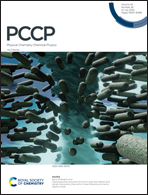Anthraquinone and its derivatives as sustainable materials for electrochemical applications – a joint experimental and theoretical investigation of the redox potential in solution†
Abstract
Anthraquinone (AQ) has long been identified as a highly promising lead structure for various applications in organic electronics. Considering the enormous number of possible substitution patterns of the AQ lead structure, with only a minority being commercially available, a systematic experimental screening of the associated electrochemical potentials represents a highly challenging and time consuming task, which can be greatly enhanced via suitable virtual pre-screening techniques. In this work the calculated electrochemical reduction potentials of pristine AQ and 12 hydroxy- or/and amino-substituted AQ derivatives in N,N-dimethylformamide have been correlated against newly measured experimental data. In addition to the calculations performed using density functional theory (DFT), the performance of different semi-empirical density functional tight binding (DFTB) approaches has been critically assessed. It was shown that the SCC DFTB/3ob parametrization in conjunction with the COSMO solvation model provides a highly adequate description of the electrochemical potentials also in the case of the two-fold reduced species. While the quality in the correlation against the experimental data proved to be slightly inferior compared to the employed DFT approach, the highly advantageous cost-accuracy ratio of the SCC DFTB/3ob/COSMO framework has important implications in the formulation of hierarchical screening strategies for materials associated with organic electronics. Based on the observed performance, the low-cost method provides sufficiently accurate results to execute efficient pre-screening protocols, which may then be followed by a DFT-based refinement of the best candidate structures to facilitate a systematic search for new, high-performance organic electronic materials.



 Please wait while we load your content...
Please wait while we load your content...